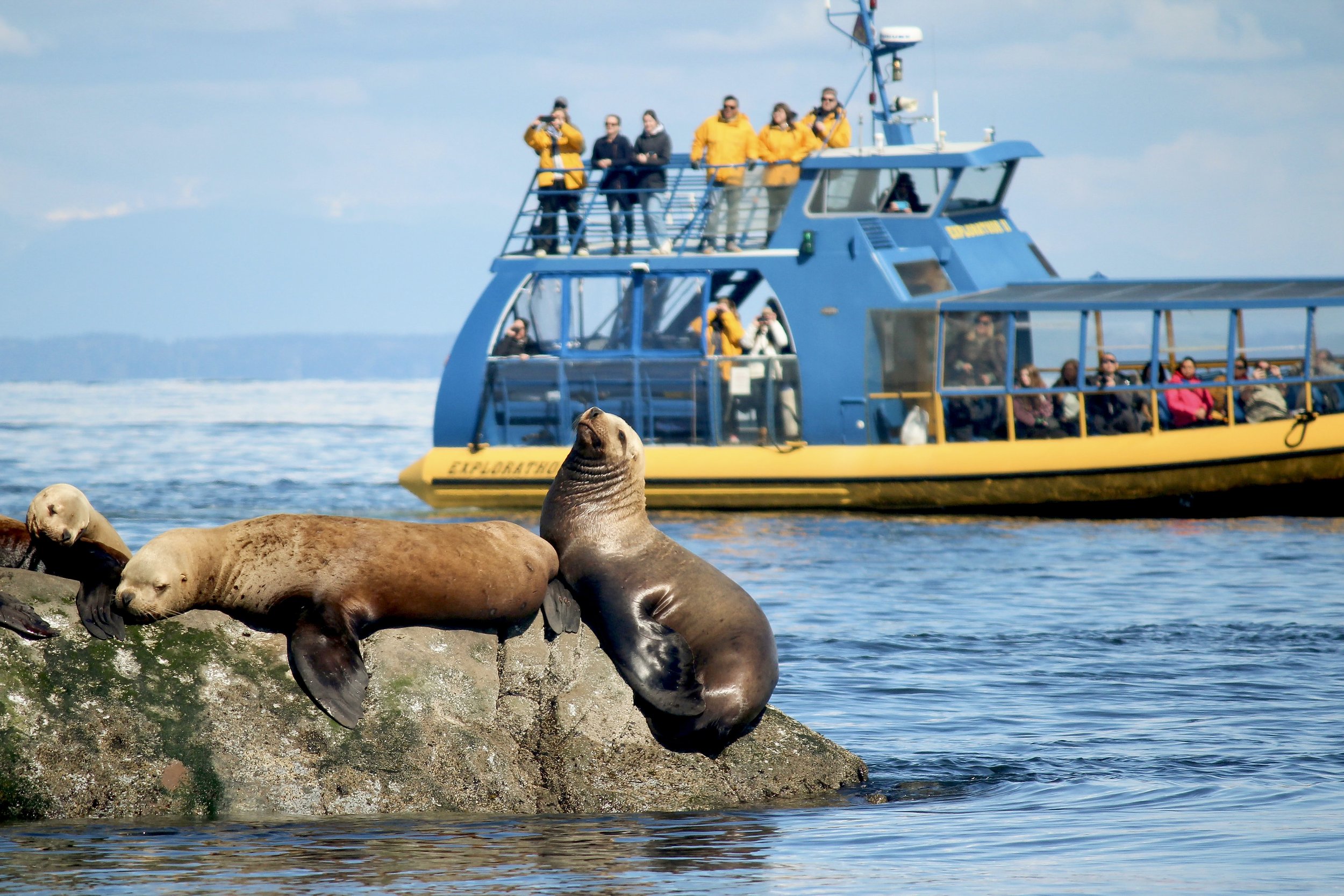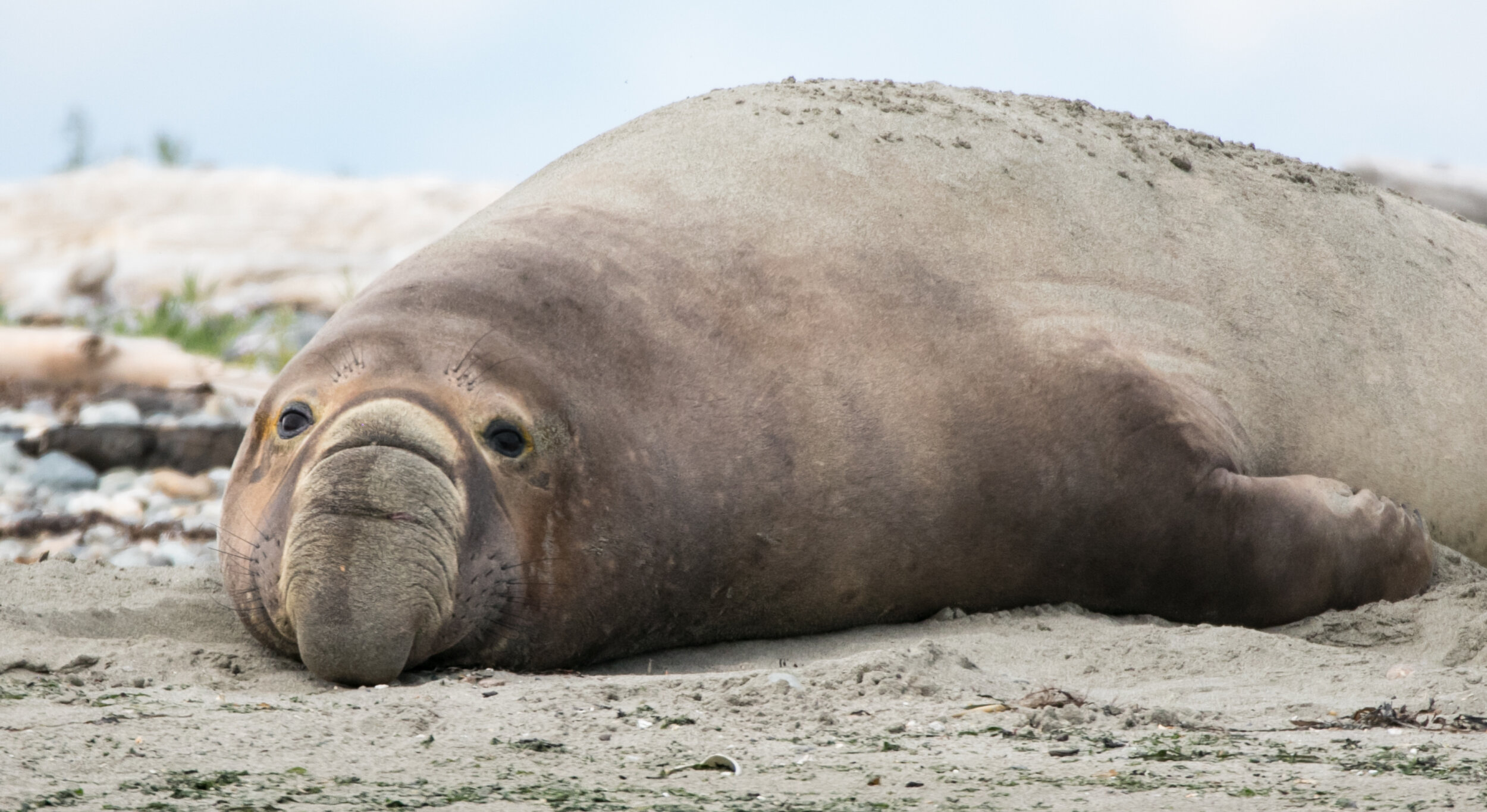
Pinnipeds & Otters
In addition to whales, the Salish Sea is home to an abundance of other marine mammals throughout the year. Four types of pinniped can be seen lounging on shorelines throughout the year - harbor seals, California sea lions, Steller’s sea lions, and Northern elephant seals. Harbor porpoise and Dall’s porpoise dart through currents with lightning speed while river and sea otters get into mischief near docks and kelp beds.
Harbor Seal
Length: Up to 6 ft. (1.83m)
Weight: Up to 370 lbs. (168kg)
Lifespan: Up to 25 years
Diet: Fish, cephalopods, crustaceans
Presence: Year-round, summer pupping season
Harbor seals are the most common pinnipeds in the Salish Sea and are frequently seen “hauled out”, or sitting on shore warming themselves. Harbor seal pups have to grow up fast, staying with their moms for just 30 days before heading off on their own. During this time, it’s common to see pups alone on the beach while mom is out looking for food. This is no cause for alarm, and humans should be sure to leave the pups alone so mom can find them easily when she returns.
California Sea Lion
Length: Up to 8 ft. (2.44m)
Weight: Up to 1,000 lbs. (456kg)
Lifespan: 20-30 years
Diet: Fish, octopus, squid
Presence: Year-round
The signature bark of a California sea lion can be heard at docks and rocky haul-outs throughout the Salish Sea. These voracious hunters with hefty appetites have sometimes clashed with fishermen who share the same affinity for local fish, but sea lions play a very important part in the local ecosystem and are a primary food source for Bigg’s, or mammal-eating killer whales. Unlike harbor seals, sea lions have long, flexible front flippers that allow them to maneuver more easily on land. They also have visible ear flaps, unlike true seals which have only a small ear hole.
Steller’s Sea Lion
Length: Up to 11 ft. (3.35m)
Weight: Up to 2,400 lbs. (1,088kg)
Lifespan: 18-25 years
Diet: Fish, octopus, squid
Presence: Year-round with peak fall through spring
Steller’s sea lions, named for German naturalist Georg Wilhelm Steller, are much larger than their California sea lion cousins. Once endangered, their population has recovered nicely and we are now fortunate to see Steller’s sea lions throughout the Salish Sea. During the summer months, most Steller’s swim out to the outer coast to breed, returning for the fall, winter, and spring. You haven’t lived until you’ve gotten a downwind whiff of one of these behemoths!
Northern Elephant Seal
Length: Up to 13 ft. (3.96m)
Weight: Up to 4,500 lbs. (2,040kg)
Lifespan: 20 years
Diet: Squid, deepwater fish, sharks, skates, and rays
Presence: Possible sightings year-round with peak spring through fall
Northern elephant seals are the largest pinnipeds that call the Salish Sea home. They get their name from the large proboscis, or “trunk”, that adult males possess. These giants spend most of their life at sea, coming ashore for just two months a year to breed and molt, or shed their coat. They can dive down nearly a mile and hold their breath for nearly two hours at a time. In fact, they even nap underwater. Once hunted for their blubber, this species nearly went extinct by the end of the 19th century, but once protected, they were able to make a terrific comeback, with a current population estimate of more than 170,000 animals.
Sea Otter
Length: Up to 5ft. (1.52m)
Weight: Up to 100 lbs. (45kg)
Lifespan: 25 years
Diet: Shellfish, urchin, crustaceans
Presence: Possible sightings year-round. Sightings rare but increasing
Sea otters have the thickest fur of any mammal on the planet with approximately one million hairs per square inch! This dense coat made them an idea target for fur traders in the 18th and 19th centuries. After a moratorium on hunting sea otters passed in 1911, the species began the slow road to recovery. While sightings of sea otters in the Salish Sea are somewhat rare and localized, we have seen an increase in sightings in the last few years. Sea otters play an important role in kelp forest ecosystem by eating urchins that feed on the kelp.
River Otter
Length: Up to 4.5 (1.37m)
Weight: Up to 35lbs. (15.8kg)
Lifespan: 15 years
Diet: Fish, crustaceans, shellfish, and amphibians
Presence: Year-round near shorelines and marinas
Despite their name, river otters also inhabit saltwater environments and are spotted often along rocky shores, foraging for snacks. Unlike sea otters who spend most of their time in the water, river otters have long, slender bodies, allowing them to move just as quickly on land as they do on the water.







